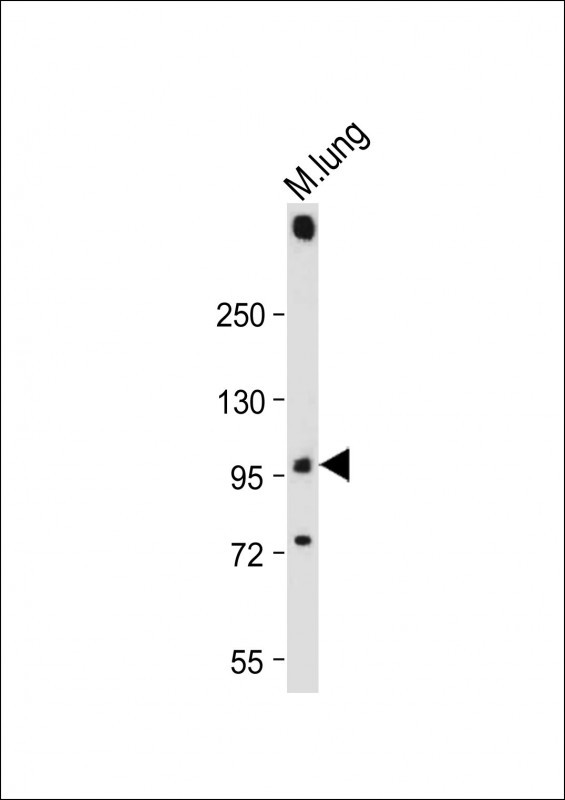PLD2 Antibody (N-term)
Affinity Purified Rabbit Polyclonal Antibody (Pab)
- SPECIFICATION
- CITATIONS: 4
- PROTOCOLS
- BACKGROUND

Application
| WB, E |
|---|---|
| Primary Accession | O14939 |
| Other Accession | Q0V8L6, NP_002654.3 |
| Reactivity | Human, Mouse |
| Predicted | Bovine |
| Host | Rabbit |
| Clonality | Polyclonal |
| Isotype | Rabbit IgG |
| Calculated MW | 105987 Da |
| Antigen Region | 10-39 aa |
| Gene ID | 5338 |
|---|---|
| Other Names | Phospholipase D2, PLD 2, hPLD2, Choline phosphatase 2, PLD1C, Phosphatidylcholine-hydrolyzing phospholipase D2, PLD2 |
| Target/Specificity | This PLD2 antibody is generated from rabbits immunized with a KLH conjugated synthetic peptide between 10-39 amino acids from the N-terminal region of human PLD2. |
| Dilution | WB~~1:2000 E~~Use at an assay dependent concentration. |
| Format | Purified polyclonal antibody supplied in PBS with 0.09% (W/V) sodium azide. This antibody is purified through a protein A column, followed by peptide affinity purification. |
| Storage | Maintain refrigerated at 2-8°C for up to 2 weeks. For long term storage store at -20°C in small aliquots to prevent freeze-thaw cycles. |
| Precautions | PLD2 Antibody (N-term) is for research use only and not for use in diagnostic or therapeutic procedures. |
| Name | PLD2 (HGNC:9068) |
|---|---|
| Function | Function as phospholipase selective for phosphatidylcholine (PubMed:9582313). May have a role in signal-induced cytoskeletal regulation and/or endocytosis (By similarity). |
| Cellular Location | Cell membrane {ECO:0000250|UniProtKB:P97813}; Lipid-anchor {ECO:0000250|UniProtKB:P97813} |
| Tissue Location | Ubiquitous.. |

Provided below are standard protocols that you may find useful for product applications.
Background
Phosphatidylcholine (PC)-specific phospholipases D (PLDs; EC 3.1.4.4) catalyze the hydrolysis of PC to produce phosphatidic acid and choline. Activation of PC-specific PLDs occurs as a consequence of agonist stimulation of both tyrosine kinase and G protein-coupled receptors. PC-specific PLDs have been proposed to function in regulated secretion, cytoskeletal reorganization, transcriptional regulation, and cell cycle control.[supplied by OMIM].
References
Chae, Y.C., et al. Mol. Cell. Biol. 30(21):5086-5098(2010)
Bailey, S.D., et al. Diabetes Care 33(10):2250-2253(2010)
Knapek, K., et al. Mol. Cell. Biol. 30(18):4492-4506(2010)
Tabatabaian, F., et al. J. Biol. Chem. 285(25):18991-19001(2010)
Kang, D.W., et al. PLoS ONE 5 (8), E12109 (2010) :
If you have used an Abcepta product and would like to share how it has performed, please click on the "Submit Review" button and provide the requested information. Our staff will examine and post your review and contact you if needed.
If you have any additional inquiries please email technical services at tech@abcepta.com.














 Foundational characteristics of cancer include proliferation, angiogenesis, migration, evasion of apoptosis, and cellular immortality. Find key markers for these cellular processes and antibodies to detect them.
Foundational characteristics of cancer include proliferation, angiogenesis, migration, evasion of apoptosis, and cellular immortality. Find key markers for these cellular processes and antibodies to detect them. The SUMOplot™ Analysis Program predicts and scores sumoylation sites in your protein. SUMOylation is a post-translational modification involved in various cellular processes, such as nuclear-cytosolic transport, transcriptional regulation, apoptosis, protein stability, response to stress, and progression through the cell cycle.
The SUMOplot™ Analysis Program predicts and scores sumoylation sites in your protein. SUMOylation is a post-translational modification involved in various cellular processes, such as nuclear-cytosolic transport, transcriptional regulation, apoptosis, protein stability, response to stress, and progression through the cell cycle. The Autophagy Receptor Motif Plotter predicts and scores autophagy receptor binding sites in your protein. Identifying proteins connected to this pathway is critical to understanding the role of autophagy in physiological as well as pathological processes such as development, differentiation, neurodegenerative diseases, stress, infection, and cancer.
The Autophagy Receptor Motif Plotter predicts and scores autophagy receptor binding sites in your protein. Identifying proteins connected to this pathway is critical to understanding the role of autophagy in physiological as well as pathological processes such as development, differentiation, neurodegenerative diseases, stress, infection, and cancer.




